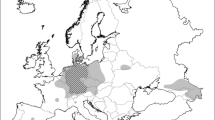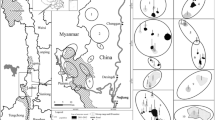Abstract
In this study we present the results of a baseline study designed to assess the status of the raccoon (Procyon lotor) throughout Spain. The species was reported in 28 localities, mostly consisting of sporadic observations of single individuals. In central Spain an apparently thriving population of raccoons has been recently discovered. Our data confirmed the spread of feral raccoons throughout this region, where the species has already colonized about 100 km of streams and rivers. Predation on local fauna was also proved, and the first approximation for spatial movement and habitat use analyses in Spain is presented. Our results suggest that deliberate releases of raccoons by pet owners are an important cause for the existence of feral raccoons in Spain. Further research should focus on monitoring established individuals to collect detailed data on their population and reproductive parameters. Meanwhile, urgent actions should be taken to stop releases into the wild and to control and eradicate this unwelcome invasive species.

Similar content being viewed by others
References
Álvarez A (2008) Predation of Spanish terrapin Mauremys leprosa clutches by raccoons. Quercus 269:49 (in Spanish)
Barona J, García-Román L (2005) Presence of raccoons (Procyon lotor) in the Regional Park of Sureste (Madrid): current distribution and relative abundance. In: Proceedings of the VIII national congress of the Spanish Society for the Conservation and Study of Mammals (SECEM), Huelva, p 15 (in Spanish)
Bartoszewicz M (2006) NOBANIS—invasive alien species fact sheet—Procyonlotor. From: database of the North European and Baltic Network on Invasive Alien Species. NOBANIS, http://www.nobanis.org. Date of access 31 Mar 2011
Bartoszewicz M, Okarma H, Zalewski A, Szczęsna J (2008) Ecology of the raccoon (Procyon lotor) from western Poland. Ann Zool Fennici 45:291–298
Canova L, Rossi S (2008) First records of the northern raccoon Procyon lotor in Italy. Hystrix It J Mamm 19:179–182
Frantz AC, Cyriacks P, Schley L (2005) Spatial behaviour of a female raccoon (Procyon lotor) at the edge of the species’ European distribution range. Eur J Wildl Res 51:126–130
García FJ, González JL, Aramburu MJ, Pliego B, Prieto B, Prada C (2007) Management of Raccoon populations in the Comunidad Autónoma de Madrid. In: Proceedings of the VIII national congress of the Spanish Society for the Conservation and Study of Mammals (SECEM), Huelva, p 79 (in Spanish)
García FJ, Cortés Y, Herrera J, García-Román L, Aramburu MJ, Prieto B, Pliego B (2009) The raccoon Procyon lotor in central Spain. Research and management of an invasive alien species. In: Proceedings of the IX national congress of the Spanish Society for the Conservation and Study of Mammals (SECEM), Bilbao, p 83 (in Spanish)
Helgen KM, Maldonado JE, Wilson DE, Buckner SD (2008) Molecular confirmation of the origin and invasive status of West Indian raccoons. J Mammal 89:282–291
Ikeda T, Asano M, Matoba Y, Abe G (2004) Present status of invasive alien raccoon and its impact in Japan. Global Environ Res 8:125–131
Kauhala K (1996) Introduced carnivores in Europe with special reference to central and northern Europe. Wildl Biol 2:197–204
Küchle M, Knorr HLJ, Medenblik-Frysch S, Weber A, Bauer C, Naumann GOH (1993) Diffuse unilateral subacute neuroretinitis syndrome in a German most likely caused by the raccoon roundworm, Baylisascaris procyonis. Graefe’s Arch Clin Exp Ophthalmol 231:48–51
Mack RN, Simberloff D, Lonsdale WM, Evans H, Clout M, Bazzaz FA (2000) Biotic invasions: causes, epidemiology, global consequences, and control. Ecol Appl 10:689–710
Martí R, Del Moral JC (2002) Wintering birds in Spain. Dirección General de Conservación de la Naturaleza/SEO-BirdLife. OAPN, Ministry of the Environment, Madrid, p 309 (in Spanish)
Okabe F, Agetsuma N (2007) Habitat use by introduced raccoons and native raccoon dogs in a deciduous forest of Japan. J Mammal 88:1090–1097
Park SY, Glaser C, Murray WJ, Kazacos KR, Rowley HA, Fredrick DR, Bass N (2000) Raccoon roundworm (Baylisascaris procyonis) encephalitis: case report and field investigation. Pediatrics 106:E556
Pinya S, Perelló E, Álvarez C (2009) Notes on the presence of raccoon Procyon lotor (Linnaeus, 1758) in the island of Majorca. Galemys 21:61–64 (in Spanish)
Rabinowitz AR, Potgieter LND (1984) Serologic survey for selected viruses in a population of raccoons, Procyon lotor (L.), in the Great Smoky Mountains. J Wildl Dis 20:146–148
Randall EJ, Bauman K, King M, Gompper ME (2007) A serologic assessment of exposure to viral pathogens and leptospira in an urban raccoon (Procyon lotor) population inhabiting a large zoological park. J Zoo Wildl Med 38:18–26
Riley SD, Hadidian J, Manski DA (1998) Population density, survival and rabies in racoons in an urban national park. Can J Zool 76:1153–1164
Schrader B, Hennon P (2005) Assessment of invasive species in Alaska and its national forests. United States Department of Agriculture and Forest Service, Regional Office, Anchorage
Simberloff D (2003) How much information on population biology is needed to manage introduced species? Conserv Biol 17:83–92
Wandeler A, Salsberg DE (1999) Raccoon rabies in eastern Ontario. Can Vet J 40:731
Zeveloff SI (2002) Raccoons: a natural history. UBC Press, Vancouver and Smithsonian Institution Press, Washington
Acknowledgments
We would like to thank the staff working on wildlife conservation in the Regional Park Parque Regional del Sureste, Comunidad Autónoma de Madrid, Comunidad Autónoma de Valencia (J. Jiménez) and Comunidad Autónoma de Castilla-La Mancha (Guadalajara Province) for their help in this research (captures) and for providing data on raccoon presence. Capture authorizations were provided by the Comunidad Autónoma de Madrid according to the EU laws. The study was partially financed by the Regional Park Parque Regional del Sureste and the Comunidad Autónoma de Madrid.
Author information
Authors and Affiliations
Corresponding author
Rights and permissions
About this article
Cite this article
García, J.T., García, F.J., Alda, F. et al. Recent invasion and status of the raccoon (Procyon lotor) in Spain. Biol Invasions 14, 1305–1310 (2012). https://doi.org/10.1007/s10530-011-0157-x
Received:
Accepted:
Published:
Issue Date:
DOI: https://doi.org/10.1007/s10530-011-0157-x




